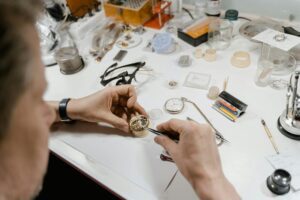Common Watch Repairs: A Fundamental Guide
Watch owners everywhere know the dreaded feeling of a malfunctioning watch. Whether the cause of the issue is known or not, nearly all watches will need to be repaired at one point or another. The good news is that when you take your watch to a trusted watchmaker for repair, you can rest assured that your watch will be diagnosed, repaired, and returned to you in perfect condition.

Signs Your Watch Needs a Repair
Sometimes your watch may be obviously faulty—maybe you’ve noticed that its time is way off, or you can hear strange noises coming from its movement. Other times, the signs may not be as obvious. You should take your watch in for a repair if you notice any of these issues:
- The crystal is cracked or shattered
- The case is dented
- You see moisture droplets inside the crystal (these can come and go)
- Your watch is gaining or losing time
- You hear a rattling or grinding noise inside the watch
If you can see damage—like if the watch crystal is cracked or the case is dented—you should take it in for a repair. Aside from being a cutting hazard, a broken crystal can mean that shards of glass have gotten into the movement. Likewise, if you see a dent, it’s likely the delicate parts inside have been damaged and knocked out of place.
If you can see moisture inside the crystal, this indicates that your watch’s sealings have come loose and water has gotten into the watch. This will cause the movement to rust or corrode, so it will need to be repaired immediately.
If you hear a rattling or grinding noise, that usually means something has come loose inside the watch and may be grinding against the gears. This is also an urgent problem that should be fixed immediately.
Even if you can’t see or hear any apparent issues with your watch, you should take it in if it’s gaining or losing time.
Common Watch Repairs
Quartz Watches
If you have a quartz watch, battery replacement is the most common repair. When your quartz watch starts to lose time or skip seconds, it almost always indicates that the battery is dying. Luxury quartz watch owners should be especially wary of this—the acid from a dying battery can leach out and destroy the delicate inner parts, and this type of repair is even more expensive for luxury watches.
Even if you don’t need watch repair, be prompt about battery replacement for your Rolex, Armani, Longines, or any other watch. Battery replacement is the most common quartz watch repair, but it can become a more costly repair when you wait too long.
Mechanical and Automatic Watches
Mechanical and automatic watches have anywhere from 180 to 500 moving parts inside their case. This means that any number of things could go wrong.
Aside from the above-mentioned problems, a mechanical or automatic watch that hasn’t been serviced in a while or has loose sealings will have an issue with dried-out lubricants. Replacing the lubricant and any grinding gears from dried oil is a very common watch repair.
All Watches
No matter the type of watch you have, these are some of the most common repairs you’ll need to have done on your watch:
- Crystal replacement
- Dial restoration
- Band replacement
- Demagnetization of movement
That last item might sound odd, but it’s reasonably common. If a watch is exposed to a magnetic field (often generated by household appliances), the inner pieces will be moved out of place.
Watchmakers also handle servicing tasks like cleaning, polishing, adding more lubricant, and pressure testing. A pressure test will reveal any issues with your watch’s sealings; any loose sealings will allow dirt, dust, and moisture into your watch.
Why Not Fix It Myself?
Some watch owners think that because these repairs are common, they must be easy enough to do by themselves instead of bringing their watches to a watch repair shop. This is a bad idea for many reasons.
First, an untrained person opening the watch risks damaging the watch case and sealings. Beyond that, once the inside of the watch is exposed, it’s open to dust in the air that could compromise the watch. Sure, you could try to clear out any accumulated dust, but that’s very risky if you don’t know your way around the inner workings of a watch. Each of the hundreds or thousands of parts is tiny and delicate, so just one wrong move can cause catastrophic damage. In short, unless you’re a trained watchmaker, you can turn a minor problem into a massive, costly issue.
Service Your Watch Regularly
Because watches are so intricate, they need to be serviced every few years to maintain peak performance and ensure all the parts are working correctly. This can help prevent future repairs.
When a watch does malfunction, the cause is usually easy to determine, and the watchmaker can perform a standard repair. However, just because the repair is common doesn’t mean it’s easy. Enlist the help of a certified watch repair team. They can get to know your watch and keep it ticking for years to come.

